Though it’s outside, there’s really nothing all that natural about the picture-perfect lawn. Artificially grown, watered, fertilized, and maintained, it’s a strange picture of modernity. We’ve made our case against the “normal” patch of featureless fescue, and if you agree with us, perhaps you’re ready to change up the backyard for something new and less wasteful.
Watch The Video
But we understand that it can be hard to buck convention. Old habits die hard, and changing things can be difficult when you’re doing it alone in your community. Even if you’re clear-eyed enough to see how unnecessary a dumb carpet of grass is to the quality of life, your nosy neighbors or homeowner’s association (HOA) are usually not sympathetic to your views.
Change is slow. So in the meantime, if you absolutely must have a lawn-ish thing in front of your house, but want to get out of the useless grass growing business, there are many options for you to consider to keep that ground covered.
Ground cover plants certainly need not be limited to grass. The very definition of ground cover from a landscaping perspective is a low-growing, low-maintenance, perennial, spreading plant that keeps the ground from being bare.
Note: This is a different plant than a cover crop.
Related Post: Cover Crops
The world of plants that fit the ground cover bill is diverse and fascinating, and some are specialists where grass falls short. Do you have shady areas that are looking a bit naked? Maybe a slope too steep and eroding to support turf? Peruse this list of non-traditional, fabulous ground covers that might be exactly what you need.
1. Oregano (Origanum vulgare)
- Any USDA Zone
- Most delicious ground cover
Yes, it’s that same oregano that makes your pizza sauce sing! This perennial herb grows beautifully in full sun in any zone, but it does best in areas with warm weather and well-draining soil.
Related Post: 5 Perennial Herbs for Fresh Garden Flavor All Year Long
Though any type of oregano will do, try creeping oregano O. vulgare ‘Humile’ for a low-growing, mat-forming variety. Oregano can tolerate some foot traffic but won’t put up with heavy use for long, so plant it where you can enjoy the scent without stomping on it too much.
One of my favorite memories of childhood is the oregano patch that escaped into my parent’s backyard. We always joked that their yard was barely one-third grass with all the lovely wildflowers they allowed. Every time my dad mowed, the aroma was delightful. I recall running over it often without affecting its growth.
2. Chamomile
- USDA Zones 4 to 9
- Best ground cover to harvest as tea
Chamomile releases the scent of apple and daisies with every footfall, and if you live in zones 4 to 9, you could easily grow that beauty to cover your yard. Interestingly, the plant historically used to cover those smooth, castle fields of opulence wasn’t the Kentucky bluegrass of modern suburbs, but chamomile and thyme.
Chamomile loves both full and dappled sun and requires very little mowing which results in a dense green cover dazzled with starry white blossoms. Chamaemelum nobile is a creeping variety that is lawn-suitable. A dwarf, non-flowering variety, C. nobile ‘Treneague’ will give you a fragrant, dense, evergreen mat that some say is the perfect lawn replacement.
In order to get a chamomile lawn established, you’ll need to remove the grass. They can’t tolerate competition very well. Be sure the soil is a bit airy, too. Clay and rocky soils aren’t their cup of tea (ha). Chamomile can be stepped on reasonably once established — at least after 12 weeks — but will show signs of wear if trodden daily.
3. Thyme (Thymus spp.)
- USDA Zones 5 to 8
- Drought-tolerant ground cover
If you don’t have the time to mow your lawn regularly, perhaps it is time to replace it with thyme (if you’ll forgive me for that atrocious sentence)! Consider transforming part of your landscape into an aromatic thyme garden.
Thyme is drought-tolerant, often used in the sizzling heat of full-sun rock gardens, and available in a huge array of scents, leaf patterns, and bloom colors. They are hardy through zones 5 to 8, though growers in zone 5 may find that thyme won’t survive the winter as perennials.
It may take a bit longer to get established, but once it does, it should be hassle-free. For areas where you intend to walk, look for creeping varieties like Thymus praecox ‘Coccineus’ or wooly thyme (Thymus pseudolanuginosus).
Also, if you have children running around your yard, the sensitive, delicate beauty of many types of ground cover won’t be able to handle their active games. No need to bar kids from being kids outside, though. Just plant appropriately! Both thyme and clover (see below) can handle walking, running, or somersaults.
4. White Clover (Trifolium repens)
- USDA Zones 3 to 10
- Low-maintenance and pollinator-friendly ground cover
Clover may be seen as a weed in a traditional lawn, but what if it was the whole lawn? White clover is super low-maintenance, fantastic for pollinators, thrives in drought, doesn’t grow tall, smells amazing, and won’t need to be watered or fertilized. As a legume, it is a nitrogen fixer, so you can think of it as creating its own fertilizer. It grows beautifully in zones 3 to 10 in full sun or partial shade, and it isn’t picky about soil quality.
Related Post: 6 Reasons Why I Chose Clover as a Living Mulch
There are two downsides that I see to clover. The first is that it is a little less durable than a grass lawn, but this can be easily remedied by planting grass and clover together. They’ll back up each other and give you a surface that will take the worst of what your kids and dogs can throw at it.
The second downside is that it’s considered invasive in the United States. Clover is originally a native of Europe. I have somewhat ambivalent feelings about its invasiveness, however, as it is a fantastic fodder crop, wonderful for bees, and in my opinion, far better than grass alone. There’s absolutely no chance of eradicating clover, but if you’re intending to plant an entirely native patch on your land, be aware that clover does spread and isn’t likely to go away anytime soon.
As a side note, be sure you’re planting white clover. Red clover while edible and medicinal, grows to be feet taller than the comfortable strolling-height of its more diminutive cousin.
5. Lily Turf (Liriope)
- USDA Zones 4 to 10
- Most grass-like ground cover
Also called monkey grass (though there’s a totally different family of plants that also shares the common name) and lilyturf, this easy-care perennial is a fantastic choice for borders and those awkward areas of ground between sidewalks and the road, or around trees.
If you don’t need your yard for kickball games, you could even plant this flowering relative of narcissus in the whole yard. It forms a dense cover that barely requires maintenance. It is actually damaged most by overwatering and certainly doesn’t need to be mowed — though it’s not a plant you should plan on walking over.
Grow it in full sun or partial shade in zones 4 to 10 and enjoy your extra time without maintenance. There are a few different varieties of Liriope including L. muscari (clumping), L. gigantea (giant), and L. spicata (spreading).
⚠️ Caution: Lily Turf can be invasive in some areas, particularly the spreading variety. Please research your area and make sure you select non-invasive varieties before planting this one.
6. Sweet Woodruff (Galium odoratum)
- USDA Zones 4 to 8
- Best ground cover for acidic soils
Many of us probably have some evergreen trees with bare spots surrounding them. The acid soil produced by their dropped needles is not always welcoming for growth. There are some plants, however, that can thrive in that environment, particularly if your pines and spruces are open enough to let some light hit the ground. Check through this list of native plants that tolerate acid soils (go for wild ginger and wintergreen for some bonus edible treats).
Related Post: Acid-Loving Plants
Also useful for shady, acid areas is sweet woodruff (Galium odoratum). This European beauty is a non-native but very pretty ground cover that gives off an attractive aroma and grows in shade from zones 4 to 8. With starry, compound leaves and delicate white flowers, it can fill that bare patch with grace.
Care for this plant is simple. It doesn’t need to be watered, fertilized, or really messed with except for keeping its runners contained. Like all the creeping plants in this list, it can invade surrounding areas if left unchecked.
7. Creeping Charlie (Glechoma hederacea)
- USDA Zones 5 to 9
- Fast-growing ground cover
I know, the name makes you feel like there’s a mustachioed man secretively staring at you from a fifteen-passenger van, but this pretty ground cover deserves a better reputation. Many people spend a lot of effort trying to poison it out of their lawns as a weed. It’s truly a shame because this “weed” does just great as a lawn in its own right.
It’s low growing with purple and green foliage, medicinally useful, pleasantly-flowered with little purple blooms, and able to flourish in the shade. Why does everyone hate this poor plant? You probably already have it growing in your yard if you live in zones 5 to 9. I would recommend letting it do its thing.
An issue with ground ivy, as it is also known, is keeping its invasive nature contained. If you’re interested in growing only native plants in a certain area, be on your guard against the aggressive runners. Also, it’s apparently toxic to horses, so plan accordingly.
8. Most Shade-Tolerant: Moss
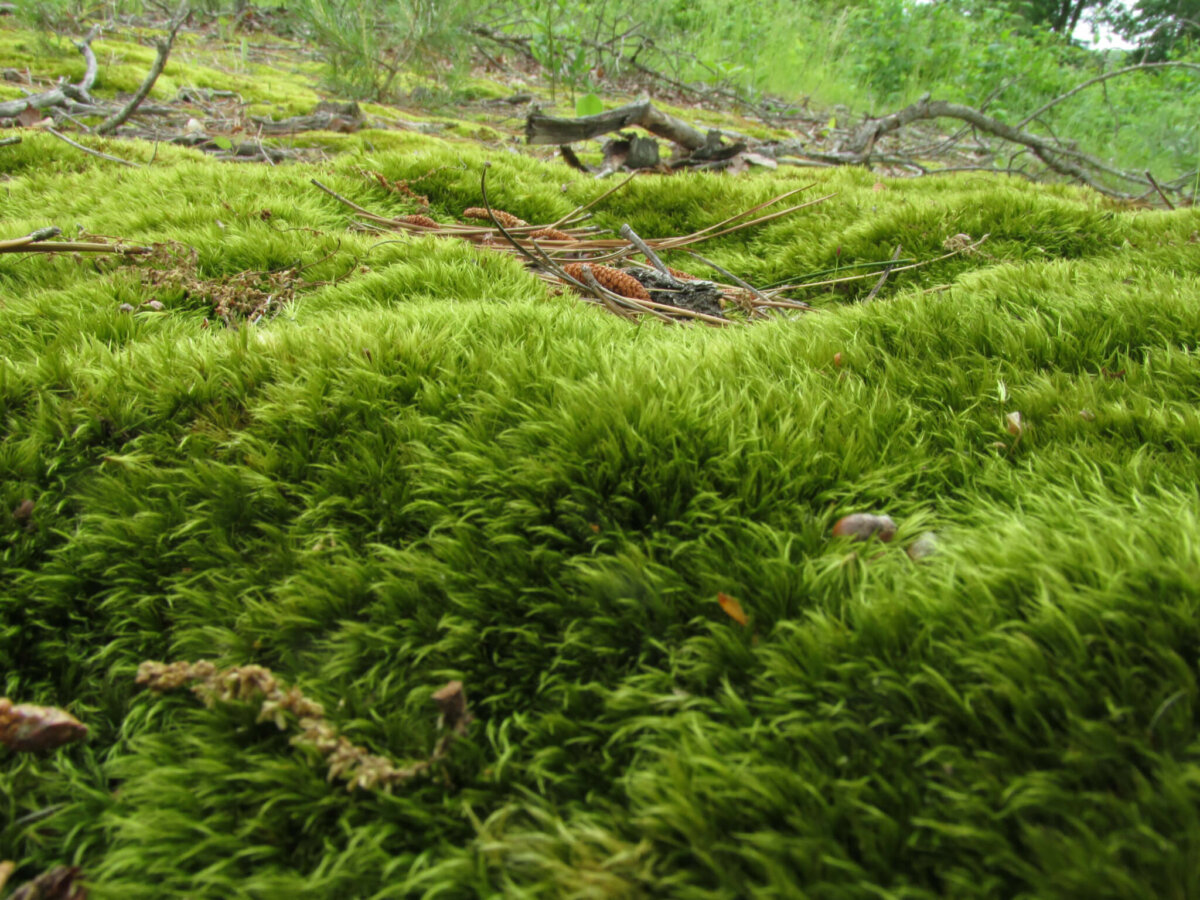
- All USDA Zones
- Most shade-tolerant ground cover
Recreate that dreamy, dense carpet of spongy green that covers forest floors with a moss bed of your own. These soft-to-walk-on carpets require no mowing and can even tolerate some foot traffic. If you’re going to be trampling them a lot, I would recommend using flagstones for the heavy-use areas and letting them fill in the gaps with their luscious green.
Related Post: Shade Plants: 15 Garden Greats To Grow In Full Or Partial Shade
Moss does require some specific situations for its best growth. The optimal choice for your area is native types that want to grow there anyway, so you’ll have to do some local research. Don’t harvest mosses from the wild. If you can, try to harvest them from your own lawn (they’re probably there) and use that as your base.
You can use a blender to make a moss slurry to propagate them (or to use as green graffiti — but that’s a whole different topic). Generally, they need acid soils, compact earth, shade, and enough moisture to keep them from drying out and turning brown.
9. Lithodora (Lithodora diffusa)
This ornamental takes a few years to spread out, but Kane here at Insteading is a big fan of it because it does a great job of blocking weeds. The blueish purple flowers show color much of the year in the Pacific Northwest and do a good job of attracting pollinators as well.
While the 4 inch or gallon pots you buy at the store will say these spread 24-36 inches wide, we’ve seen them spread up to 5 feet in diameter after 4-6 years. It spreads in a thick carpet shape and will cascade nicely over rockeries and planter edges. It grows too tall to serve as a pathway but does a good job of withstanding foot traffic if you do walk on it.
10. Let the Meadow Return!
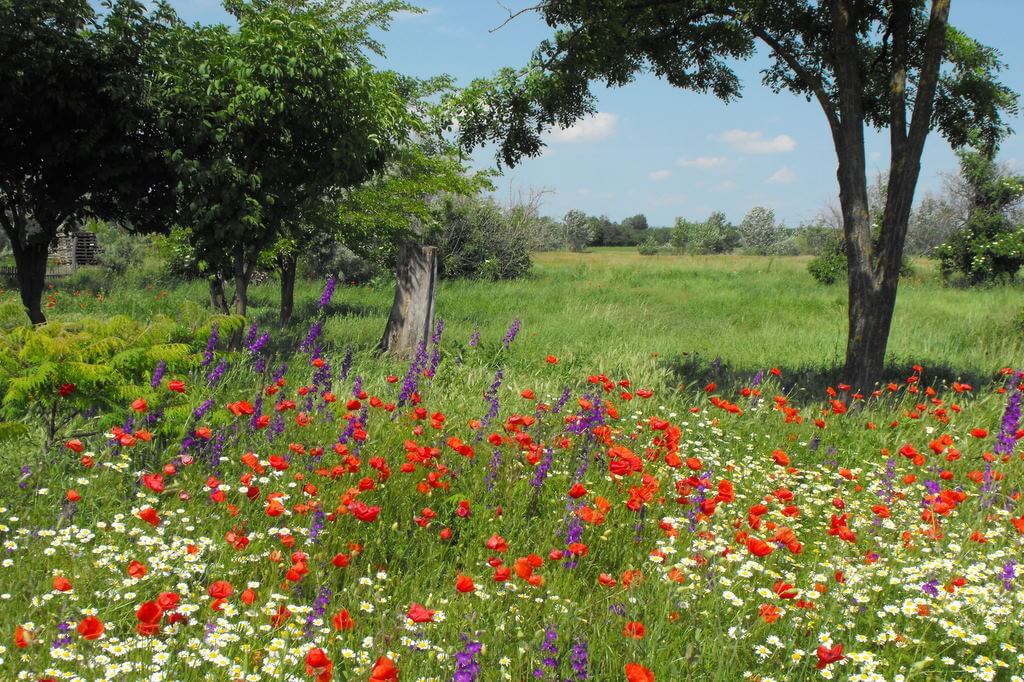
Maintaining a traditional lawn is a lot of work. You’re essentially forcing a monoculture to exist on land that wants anything but that! If you have the space for it, and the freedom to do what you want on your land without your HOA getting their panties in a bunch, consider returning the majority of your lawn back to what it was originally. For many of us, this could be a prairie, meadow, or desert xeriscape depending on your location.
- All USDA Zones
- Most low-maintenance ground cover
This return could be as simple as just letting “nature do its thing” on your property. The birds will poop out some local seeds, the wind will carry in others, and eventually, you’ll start seeing more variety than boring old grass. This is how my parents handled their lawn. They still mowed it when needed to keep it from growing too tall, but when it came time for a middle-school wildflower collection project, I found 15 of the 20 specimens required from my own backyard!
Related Post: 5 Compelling Reasons to Turn Your Lawn Into a Meadow
If you want to restore your land to a healthy, biodiverse zone of totally native plants, however, you’ll need to take out the old and bring in the new. Some beautiful and useful plants just can’t get a foothold if grass and clover are in the way. You will need to research what local, native plants could live in your area. Websites like Grow Native can help you rediscover what your land once grew.
Meadows benefit from being mowed (or scythed) only twice a year. So the weekly task of mowing the lawn is one you won’t need to put on the to-do list! Instead, you can welcome the hosts of butterflies, bees, pollinators, and birds that benefit from the food-rich habitat you’ve returned to your patch of Earth. For more information and motivation to convert at least part of your yard into a beautiful meadow, check out this article.
We may have inherited a legacy of carefully nursing non-native grasses into a bizarre, artificial carpet of featureless green, but we don’t need to accept that as our lawn-fate. Make your yard more than just an obsolete status-symbol, and transform it into something beautiful, aromatic, edible, and biodiverse.
Have any of you dared to spurn convention and gotten rid of your lawns for something better? If you have to deal with an HOA, what are your strategies for trying to make them see the light? I’d love to hear about it in the comments below!


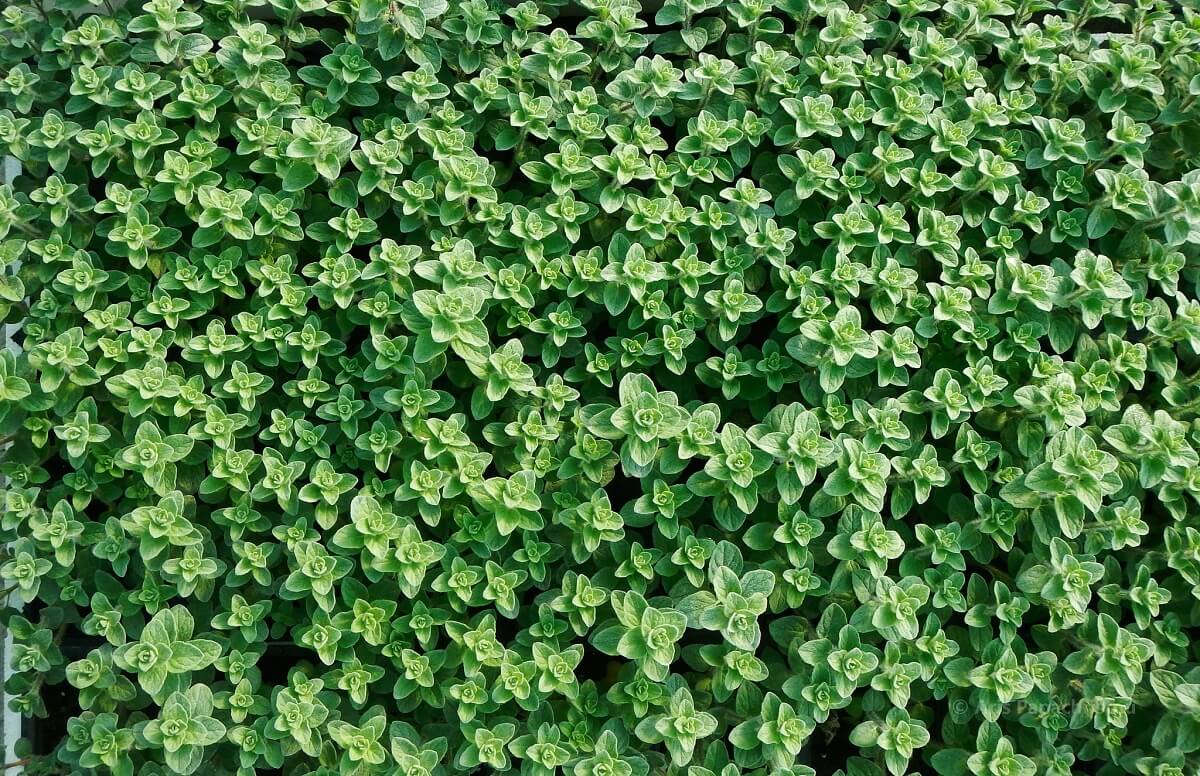
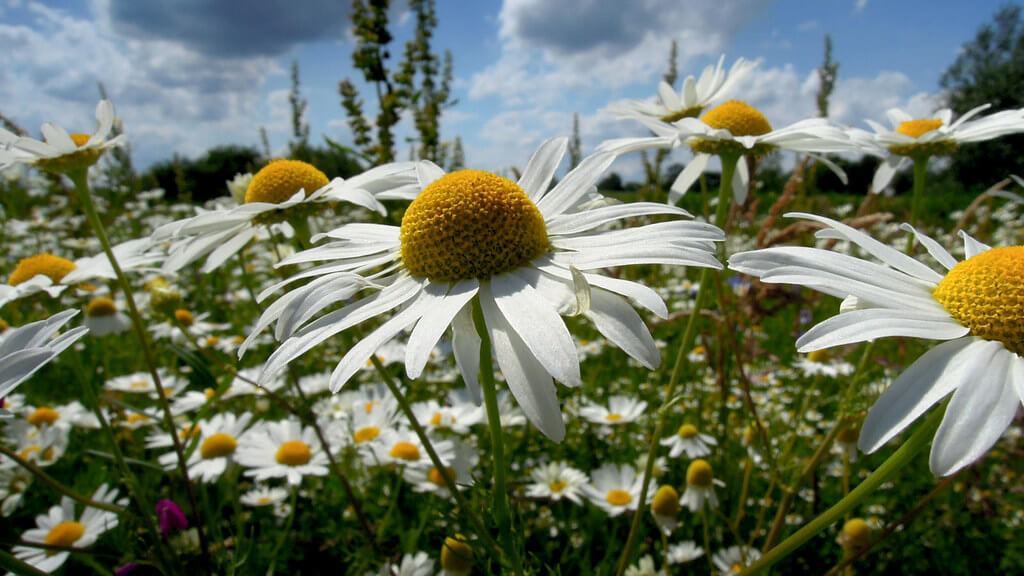
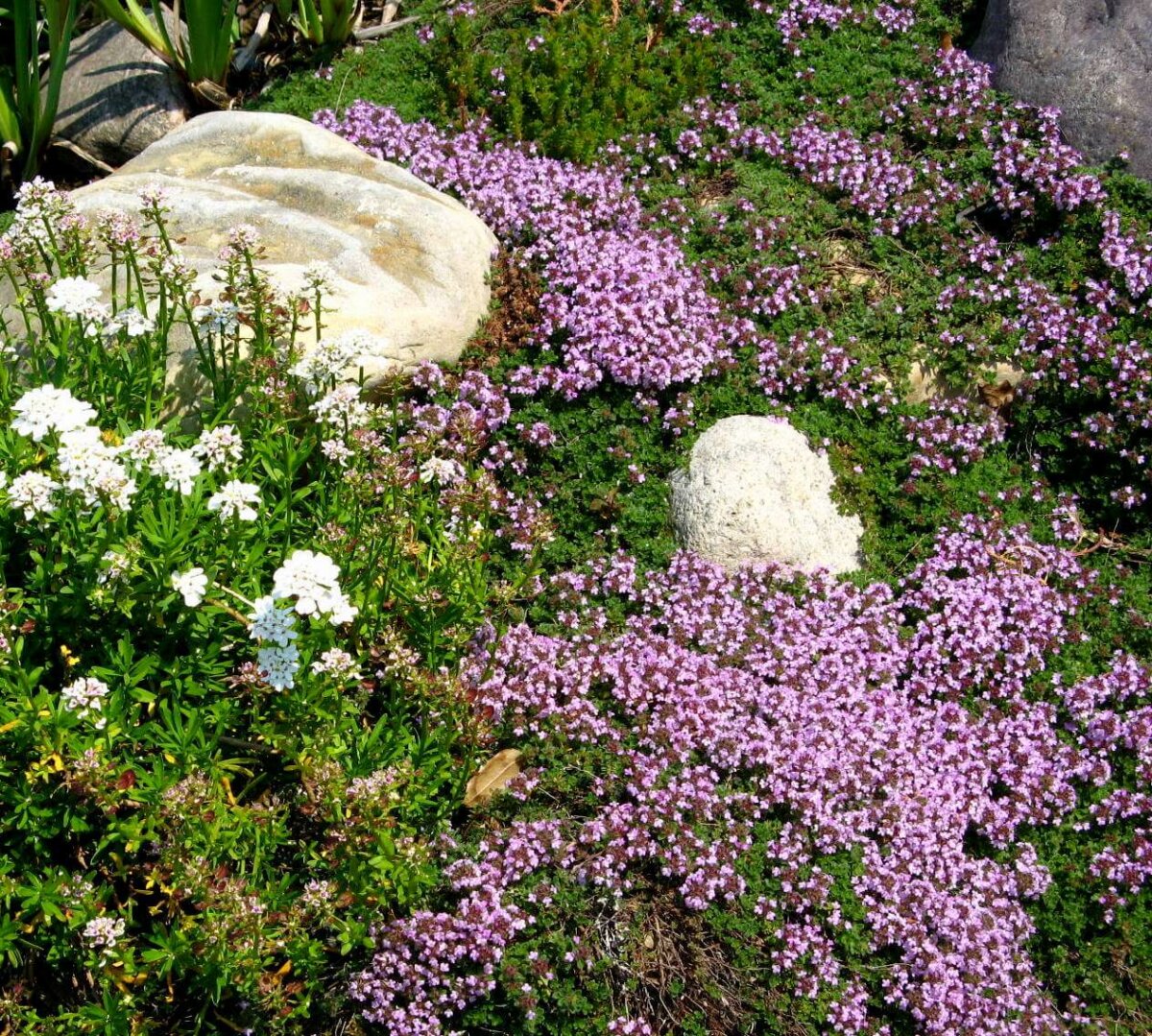
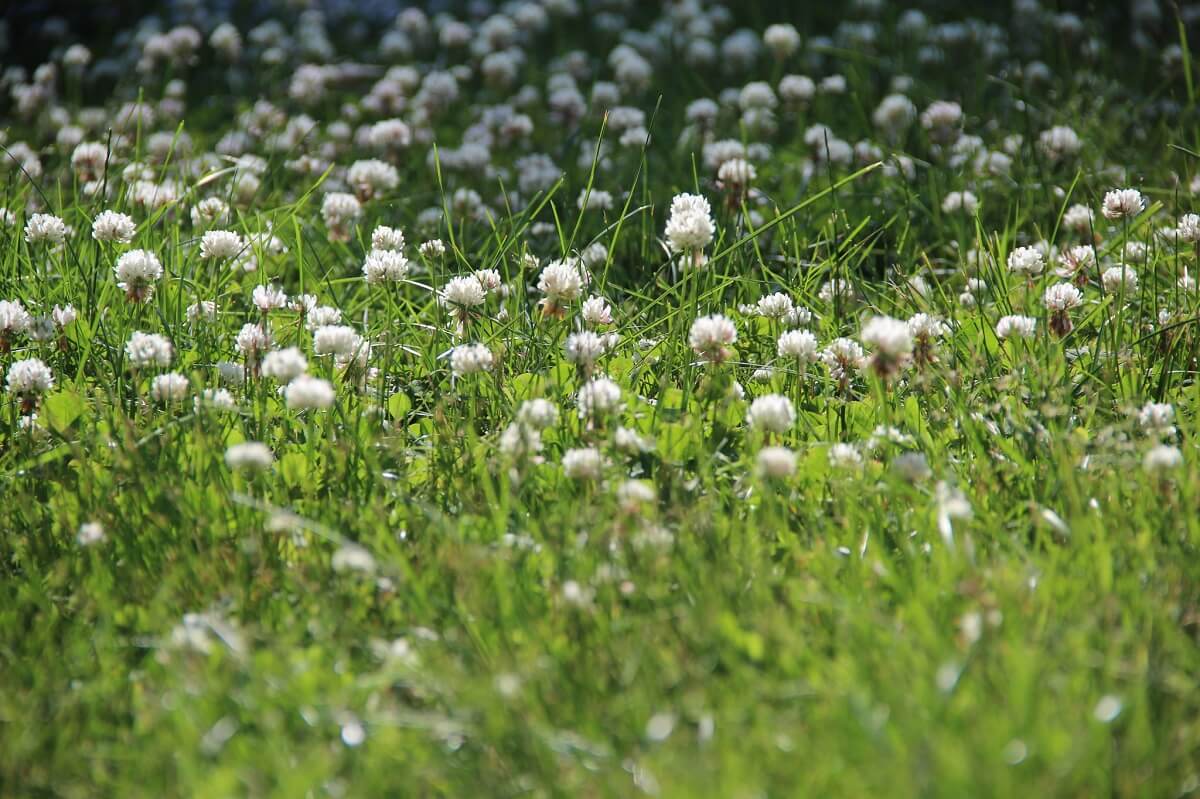
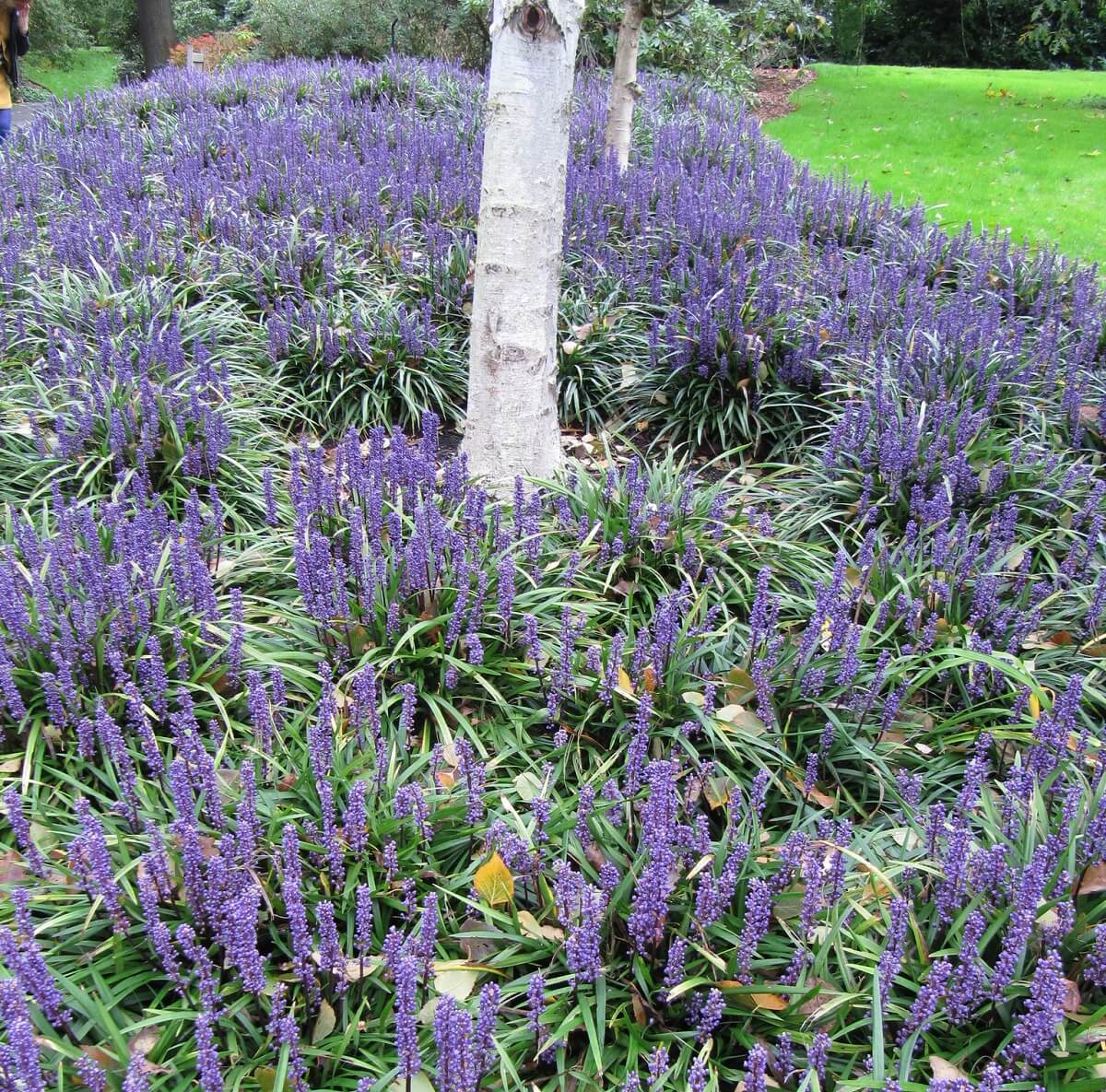
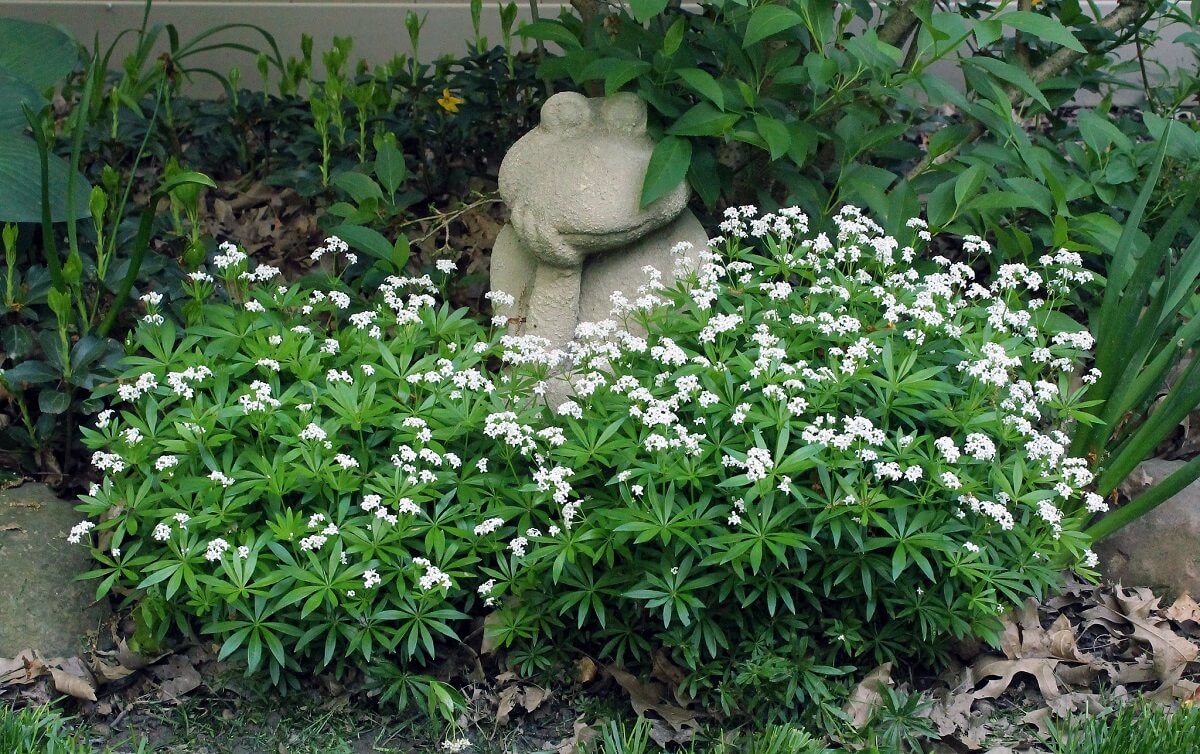
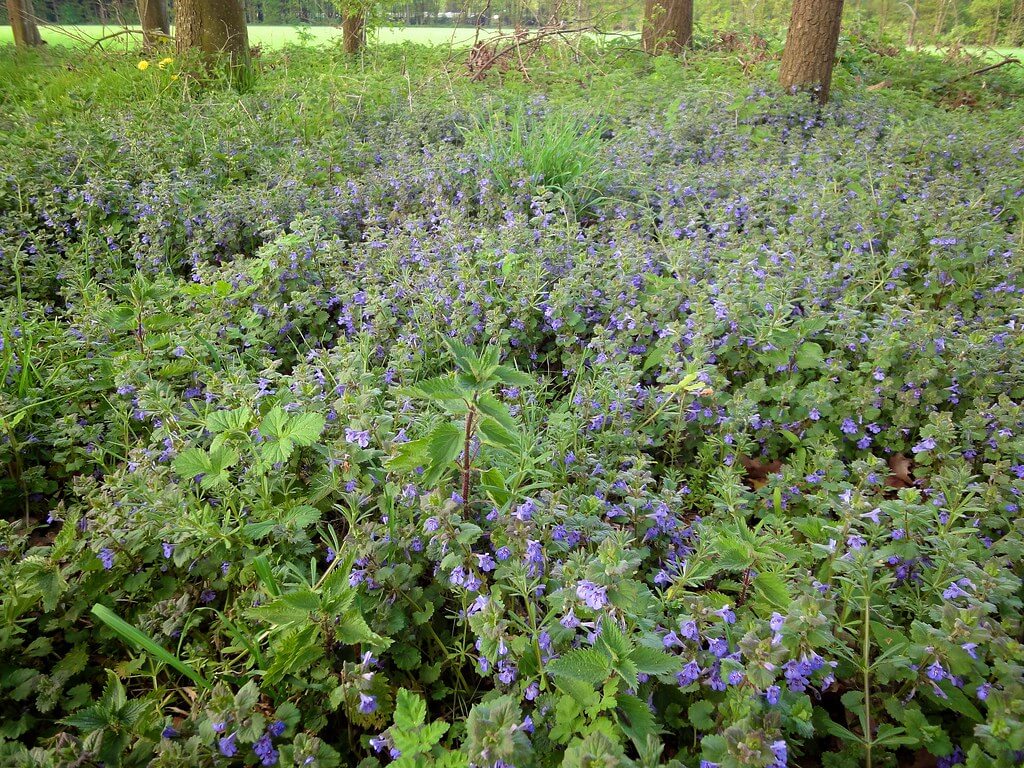







































Dear Wren and Family: Thank you so much for sharing this part of your lives with others. There is so much that Americans take for granted as “givens” that aren’t ‘given’ but adopted for some reason and then they become cultural dogma. Your article made so much sense.
Part of our family are from around Springfield, MO; are you or others among your country friends open to have people visit for a few hours to see how you homestead? If not, that is certainly understandable. God bless you all.
Hello, Richard–
Thanks so much for such a nice comment. So much of our version of homesteading is inspired by looking at the modes handed to us–like grass lawns, for example–and trying to choose to follow the good design found in creation that often seems to run counter to convention!
We’re not currently welcoming visitors to our homestead–still lots of work to do!–but I will continue to write articles based on what we’re learning here on Insteading in the meantime. 🙂 If you are interested in seeing some Missouri-based homesteading that’s years more ahead of us, check out Doug and Stacy’s homestead. (https://www.youtube.com/user/growinginfaithfarm) They’re a wonderful off-grid couple currently working on making a homestead resource center for those interested in learning more!
Here in Minnesota, many of these plants do not survive the winter, esp in low snow years. Camomile seeds prolifically and pops up all over in unintended places. Which means it is potentially invasive. Why not stick to natives? Our yard is native woodland plants under trees and prairie in sun, with a few raised bed vegetable plots. We woodchipped the last patch of lawn after our dog rototilled it and now don’t mow and never add pesticides, we water rarely. And we raise lots of native insects for the birds to feed their young. Create an ecosystem with natives!
Thanks for your comment, Anna–it’s good to have the tip on Minnesota-specific growing conditions. It’s impossible to write the perfect list of recommendations for every growing zone and country, as I’m sure you could imagine. I’d be delighted if everyone would do the research on their own to find out what works best for their specific land–chamomile is native somewhere, after all! I hope this article just provides the inspiration to get folks out of the useless non-native grass-growing business.
And I’m totally in agreement with planting natives, as you hopefully read with my last point. On our homestead, if it’s not a garden or an orchard that is covering the ground, it’s a meadow of native plants!
Hi! So happy to find your article! I’m with you 100%! I have always felt this way and have always encouraged people to just let those dandelions grow! No poisoning here. I am currently renting but hopefully will be able to jave my own meadow soon. Thanks for publishing. I hope you reach many and change the way of thinking.
What a delightful comment, Tammy! So glad to find some solidarity on this subject, and I truly hope that you can find your permanent place sometimes soon. We need more people like you!
Why you not mention perennial peanut? That is what we use un Hawaii. I would think it would be suitable / growable in other areas on the mainland with similar climates.
That’s a great suggestion for growers in zone 10! Any much further north, and the beautiful, flat-growing foliage of perennial peanut may lose the “perennial” part, haha. As I’m sure you could figure, it’s impossible to list every perfect plant in the world for every zone–I hope people can use this article as inspiration to find what’s best for their land. Thanks for the tip, Braja!
Thank you for this great article Wren.
I live in Broomfield Colorado where our soil is heavy clay(bentonite) I am told.
While I experimented with planting clover and drought tolerant seed last summer it did not take very well. I am wondering if you have a specific ground cover recommendation for this type of soil ? I’d love to replace the lawn with lower maintenance low water option.
Hey Tim! Thanks for your kind words.
Believe it or not, moss does well on clayey soil–some species like rock moss and burned ground moss/purple moss actually do really well in full sun, dry conditions, too. I’d also recommend contacting folks at Rocky Flats National Wildlife Refuge (https://www.fws.gov/refuge/rocky_flats/ ) to see what native grasses and plants are indigenous to your area and best adapted to grow well (the xeric tallgrass prairie native plants that they preserve there may be just what you’re looking for!).
Hi Tim! I’m in Aurora, CO and grew up in Parker. Although my front yard is the usual turf, the back yard is blue grama grass. I chose that over buffalo grass because I didn’t want it spreading into the flowerbeds, but it does clump. Im now considering creating a mixed lawn of buffalo and blue grama… like my parents grew… and perhaps let the buffalo work its way into the flowerbeds between the plants and groundcovers. I’m sure the thyme, sedum and veronuca will turn it back.
The way to overcome bentonite clay is to mix in large quantities (25 to 30%) of bagged mulch or top dressing, along with bloodmeal and a generous supply of micorhhizal fungi. I probably spelled that wrong… it’s a fungus that bonds with plant roots, delivering nutrients from the soil while absorbing chlorophyll from the plant. Our native grasses pretty much depend on it, when starting fresh in open ground. All your soil ammendments should be tilled or dug in to one shovel length deep… or as close to that as you can get.
Good luck!
Photo/Attachment:
The grass in my backyard is longer than a grass skirt. I have to buy a mower AND pay someone to use it. I live in PNW with rainy winters and hot sun from July through September. Will oregano and sweet woodruff eventually spread and take over the grass in a few years (my fervent wish!). I am 75 and really cant do much planting. But I can start some plants in a few areas and hope for the best. My soil is clay but drains pretty well on a hill. My spinone only runs across it 2x a week.
Sweet Woodruff does best in both shade and acid soil, so keep that in mind as you plan your grassy conquest. Oregano does eventually spread and take over areas, but it takes time, too–battling grass will really slow it down.
If you’re really serious about getting rid of grass for good, I have an idea. First, the grass needs to be killed off–trying the solarization method will keep chemicals out of your world (here’s a link to directions here–>https://www.csmonitor.com/The-Culture/Gardening/diggin-it/2011/0822/Soil-solarization-A-chemical-free-way-to-get-rid-of-weeds-and-unwanted-grass) Basically, you’d need to cut the grass as short as possible, soak the ground with water, then cover it with plastic so that the hot summer sun can cook the grass into oblivion. Then, once the grass is out of the way, you can start planting your new ground cover with much better success. Even if you just do a small patch at a time, it will get the process started.
I hope that is helpful!
Hi Wren,
We too live in the PNW, Willamette Valley, zone 8b I believe. We are seriously considering doing away with our weedy, skimpy, mossy lawn and going for ground cover. Even though I grew up with a clover lawn and love it, we’re in a neighborhood and I expect our neighbors wouldn’t be too happy at the introduction of clover or other “invasive” plants.
The less mowing the better. We are an older couple, grown kids and no pets so there’s not too much consideration for wear and tear, I imagine we’d mostly walk on it when we tend to the flower beds.
I feel the slower growing options would take too long to achieve what were hoping. We’ve heard about blue star creeper but really don’t know if it would be a good option. What are your recommendations?
Hey there, Lynn! Thanks for your question. Most of my plant knowledge comes from my gardening and naturalist experience east of the Mississippi, so I can’t give personal recommendations for plants that I know. HOWEVER, I did look up a Portland area nursery with ground cover plants that are ideal for your location–some are adapted to the growing region, others are native. Check out this list and see if one suits your needs– https://xeraplants.com/plant-type/ground-cover/. I also would recommend contacting a nature center like the Hoyt Arboretum to get their recommendations on native plants that want to grow in your lawn anyway. Then, invite your neighbors over to see how lovely plants-other-than-grass are and see if they’ll change their nosy tune! 😉
Thanks so much for the website Wren; we’ll check it out. Hoyt Arboritum is a great idea too! It’s bound to impress the neighbors. 😉
Butting in here, I’m in Portland and the are a couple of outstanding resources for reducing the grass on your property. The Soil and Water Conservation Districts run workshops and have great resources. (East Multnomah, West Multnomah, Tualatin SWCD (WA county) ok here a link to the list in OR – https://www.oregon.gov/ODA/programs/NaturalResources/SWCD/Pages/SWCD.aspx Also if you want something a little less obvious – OSU developed a seed mix called Fleur de Lawn. Takes a while to develop, basically get a aerator or those shoes with spikes and walk over your lawn,gently spread seed during the early fall when the rain has started. Do it again when it gets nicer out – late Feb. for a couple of years and it’s like the grass stays greener and slows it growth. Mow every month, or not at all. So amazing!
Thank you for a delightful and well-written article.
Thank you for this optimistic view of clover and other helpful ground covers. I’m in North Texas where the summers are HOT. My backyard is hard-packed sand and on a slope which rain washes away the little bit of turf I have left. I have a dog I don’t wish to poison. We do enjoy being outside weather permitting due to our 800 gallon fish pond and waterfall. I will be 76 later this month and am limited to much digging, etc.
How do I order some of these type ground covers? Help!
Photo/Attachment:
I removed my entire lawn and installed a xeriscape. Mostly epiphytes. I live in an HOA and they did threaten me but I already knew that Florida protects xeriscapes and prevents any interference in their construction.